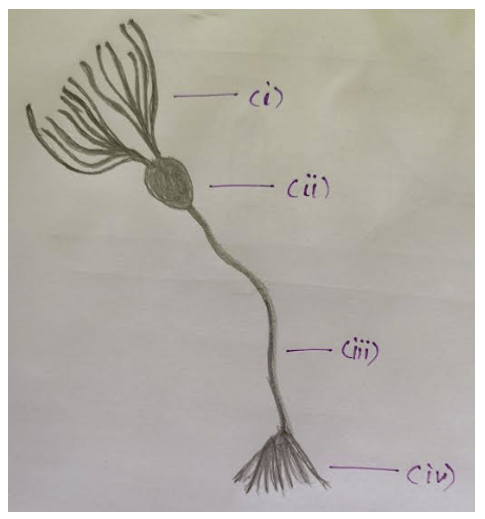This set of Marine Biotechnology Multiple Choice Questions & Answers (MCQs) focuses on “Marine Algal Biotechnology – Set 4”.
1. The whole body of seaweed is capable of photosynthesizing.
a) True
b) False
View Answer
Explanation: The main photosynthesizing portion of the thallus is blades that are leaf-like structures in seaweed but do not contain veins. However all parts in the thallus are capable of photosynthesis.
2. Most macroalgae are found on hard sediments because __________ cannot penetrate through mud/sand.
a) blades
b) float
c) stipe
d) holdfast
View Answer
Explanation: Holdfast id the lowermost root-like part of the thallus that can not penetrate through the sand or mud, it can not aid in nutrient uptake either. Therefore most macroalgae like the Sea Palm are found on hard sediments.
3. Which part in the figure is a float?

a) i
b) ii
c) iii
d) iv
View Answer
Explanation: Floats are gas-filled air bladders present in the majority of seaweeds, located just below the leaf-like veinless blades. The main function of the float is to provide buoyancy and maximize sunlight exposure.
4. What is the storage product in brown algae?
a) Laminarin
b) Starch
c) Cellulose
d) Calcium carbonate
View Answer
Explanation: The storage product in brown algae (Phaeophyceae) is laminarin. It is a glucan – polysaccharide, used as a source of carbohydrates in the algal groups. Starch is a storage product of green algae Chlorophyceae.
5. Heterokontic flagella is found in ____________
a) Brown algae
b) Red algae
c) Green algae
d) Blue-green algae
View Answer
Explanation: Heterokontic flagella is the term ascribed when the two flagellum are different in appearance. In case of Phaeophyceae, one of the flagella is smooth and the other is hairy; both are laterally inserted.
6. A clonal culture of macroalgae is free of bacteria.
a) True
b) False
View Answer
Explanation: A clonal culture of macroalgal species refers to the culture derived from a single genome set such as from a vegetative or reproductive cell, and propagates vegetatively. Unlike unialgal culture, bacteria is absent from the clonal cultures.
7. What can be added to suppress the growth of cyanobacteria in crude cultures of macroalgae?
a) Germanium oxide
b) Potassium hydroxide
c) Potassium sulphate
d) Ferric oxide
View Answer
Explanation: In cases where vegetative or reproductive cells can not be obtained from seaweeds, the whole plant or part of the plat is used for culturing, this is referred to as the crude culture. To suppress the growth of cyanobacteria and diatoms, germanium oxide is added.
8. Which is an important factor in development of callus from seaweeds?
a) Morphology
b) Thickness
c) Pigmentation
d) Phototaxis
View Answer
Explanation: For the development of a tissue culture, dedifferentiation is induced by means of hormonal injections in seaweeds and other higher plants. Thickness of the thallus is an influential trait and callus has been developed in cases where the thallus is thick enough such as in Red and Brown algae.
9. Which is not an important component of bioprocess technology development for seaweeds?
a) Increasing water weight
b) Eliciting metabolite production
c) Photo-bioreactor designing
d) Tissue culture development
View Answer
Explanation: Bioprocess technology for culturing seaweeds is essential to minimize the overexploitation of natural seaweed reserves. The three main components of the process involve tissue culture development, photo-bioreactor designing and eliciting secondary metabolite biosynthesis.
10. Protoplast isolation and somatic hybridization are the techniques used for _________ in seaweeds.
a) genetic engineering
b) bio-reactor designing
c) sampling
d) transportation
View Answer
Explanation: Protoplast isolation and subsequent fusion are the techniques used for genetic manipulation/engineering in seaweeds. This leads to manipulated seaweeds with better growth characteristics.
11. What can be used to preclude the toxic effects of papain during protoplast isolation of seaweeds?
a) Pepsin
b) Trypsin
c) BSA
d) Chymosin
View Answer
Explanation: Papain is used as a softening agent and also aiding in cuticle removal in the pre-treatment of protoplast isolation procedures. Bovine serum albumin, another protein is used to control the toxic effects of papain.
12. Which buffer is during enzymatic digestion of protoplasts?
a) PBS
b) MES
c) ADA
d) Tris
View Answer
Explanation: 2-(N-morpholino)ethanesulfonic acid – MES buffere is used to stabilize the pH and calcium ions as membrane protector during enzymatic digestion of seaweeds, for the isolation of protoplasts.
13. The isolated protoplasts from seaweed can assume a spherical shape.
a) True
b) False
View Answer
Examples: The isolated protoplasts assume a spherical shape and behave similar to animal cells. They also possess the ability to synthesize a cell wall around them in vitro. Seaweeds derived from protoplasts can also be used to study somaclonal variation.
Sanfoundry Global Education & Learning Series – Marine Biotechnology.
To practice all areas of Marine Biotechnology, here is complete set of 1000+ Multiple Choice Questions and Answers.
If you find a mistake in question / option / answer, kindly take a screenshot and email to [email protected]
